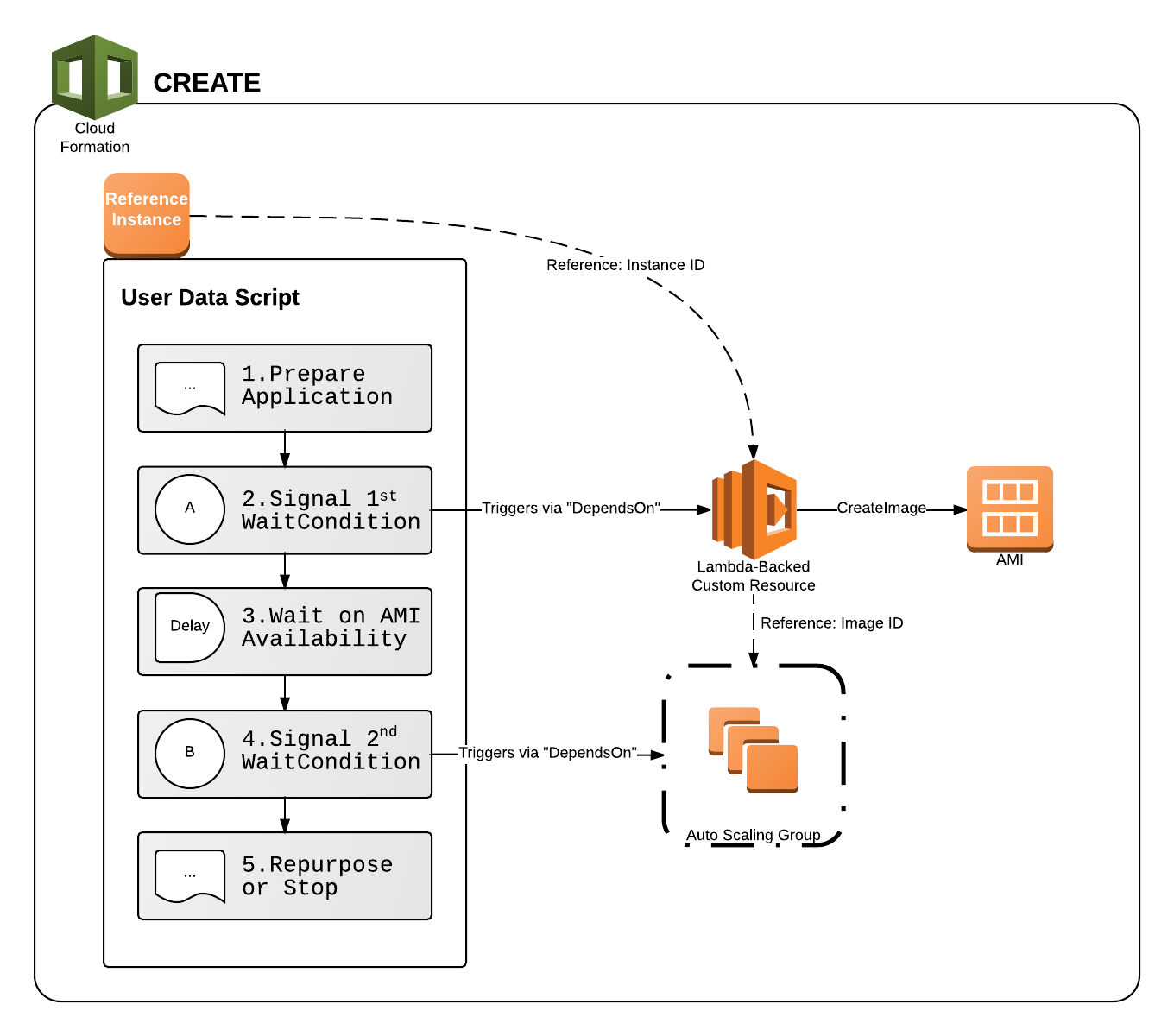AWS DevOps & Developer Productivity Blog
Faster Auto Scaling in AWS CloudFormation Stacks with Lambda-backed Custom Resources

"Resources": {
"WaitHandlePendingAMI" : {
"Type" : "AWS::CloudFormation::WaitConditionHandle"
},
"WaitConditionPendingAMI" : {
"Type" : "AWS::CloudFormation::WaitCondition",
"Properties" : {
"Handle" : { "Ref" : "WaitHandlePendingAMI" },
"Timeout" : "7200"
}
},
"WaitHandleAMIComplete" : {
"Type" : "AWS::CloudFormation::WaitConditionHandle"
},
"WaitConditionAMIComplete" : {
"Type" : "AWS::CloudFormation::WaitCondition",
"Properties" : {
"Handle" : { "Ref" : "WaitHandleAMIComplete" },
"Timeout" : "7200"
}
},
"AdminServer" : {
"Type" : "AWS::EC2::Instance",
"Properties" : {
...
"UserData": { "Fn::Base64": { "Fn::Join": [ "", [
"#!/bin/bashn",
"yum update -yn",
"",
"echo -e "n### Fetching and Installing Code..."n",
"export CODE_VERSION="", {"Ref": "CodeVersionIdentifier"}, ""n",
"# Insert application deployment code here!n",
"",
"echo -e "n### Signal for AMI capture"n",
"history -cn",
"/opt/aws/bin/cfn-signal -e 0 -i waitingforami '", { "Ref" : "WaitHandlePendingAMI" }, "' n",
"",
"echo -e "n### Waiting for AMI to be available"n",
"aws ec2 wait image-available",
" --filters Name=tag:cloudformation:amimanager:stack-name,Values=", { "Ref" : "AWS::StackName" },
" --region ", {"Ref": "AWS::Region"}
"",
"/opt/aws/bin/cfn-signal -e $0 -i waitedforami '", { "Ref" : "WaitHandleAMIComplete" }, "' n"
"",
"# Continue with re-purposing or shutting down instance...n"
] ] } }
}
},
"AMI": {
"Type": "Custom::AMI",
"DependsOn" : "WaitConditionPendingAMI",
"Properties": {
"ServiceToken": "arn:aws:lambda:REGION:ACCOUNTID:function:AMIManager",
"StackName": { "Ref" : "AWS::StackName" },
"Region" : { "Ref" : "AWS::Region" },
"InstanceId" : { "Ref" : "AdminServer" }
}
},
"AutoScalingGroup" : {
"Type" : "AWS::AutoScaling::AutoScalingGroup",
"Properties" : {
...
"LaunchConfigurationName" : { "Ref" : "LaunchConfiguration" }
}
},
"LaunchConfiguration": {
"Type": "AWS::AutoScaling::LaunchConfiguration",
"DependsOn" : "WaitConditionAMIComplete",
"Properties": {
...
"ImageId": { "Fn::GetAtt" : [ "AMI", "ImageId" ] }
}
}
}
With this approach, you don’t have to run and maintain additional servers for creating custom AMIs, and the AMIs can be deleted when the stack terminates. The following figure shows that as CloudFormation deletes the stacks, it also deletes the AMIs when the Delete signal is sent to the Lambda-backed custom resource.

Let’s look at the Lambda function that facilitates AMI creation and deletion:
/**
* A Lambda function that takes an AWS CloudFormation stack name and instance id
* and returns the AMI ID.
**/
exports.handler = function (event, context) {
console.log("REQUEST RECEIVED:n", JSON.stringify(event));
var stackName = event.ResourceProperties.StackName;
var instanceId = event.ResourceProperties.InstanceId;
var instanceRegion = event.ResourceProperties.Region;
var responseStatus = "FAILED";
var responseData = {};
var AWS = require("aws-sdk");
var ec2 = new AWS.EC2({region: instanceRegion});
if (event.RequestType == "Delete") {
console.log("REQUEST TYPE:", "delete");
if (stackName && instanceRegion) {
var params = {
Filters: [
{
Name: 'tag:cloudformation:amimanager:stack-name',
Values: [ stackName ]
},
{
Name: 'tag:cloudformation:amimanager:stack-id',
Values: [ event.StackId ]
},
{
Name: 'tag:cloudformation:amimanager:logical-id',
Values: [ event.LogicalResourceId ]
}
]
};
ec2.describeImages(params, function (err, data) {
if (err) {
responseData = {Error: "DescribeImages call failed"};
console.log(responseData.Error + ":n", err);
sendResponse(event, context, responseStatus, responseData);
} else if (data.Images.length === 0) {
sendResponse(event, context, "SUCCESS", {Info: "Nothing to delete"});
} else {
var imageId = data.Images[0].ImageId;
console.log("DELETING:", data.Images[0]);
ec2.deregisterImage({ImageId: imageId}, function (err, data) {
if (err) {
responseData = {Error: "DeregisterImage call failed"};
console.log(responseData.Error + ":n", err);
} else {
responseStatus = "SUCCESS";
responseData.ImageId = imageId;
}
sendResponse(event, context, "SUCCESS");
});
}
});
} else {
responseData = {Error: "StackName or InstanceRegion not specified"};
console.log(responseData.Error);
sendResponse(event, context, responseStatus, responseData);
}
return;
}
console.log("REQUEST TYPE:", "create");
if (stackName && instanceId && instanceRegion) {
ec2.createImage(
{
InstanceId: instanceId,
Name: stackName + '-' + instanceId,
NoReboot: true
}, function (err, data) {
if (err) {
responseData = {Error: "CreateImage call failed"};
console.log(responseData.Error + ":n", err);
sendResponse(event, context, responseStatus, responseData);
} else {
var imageId = data.ImageId;
console.log('SUCCESS: ', "ImageId - " + imageId);
var params = {
Resources: [imageId],
Tags: [
{
Key: 'cloudformation:amimanager:stack-name',
Value: stackName
},
{
Key: 'cloudformation:amimanager:stack-id',
Value: event.StackId
},
{
Key: 'cloudformation:amimanager:logical-id',
Value: event.LogicalResourceId
}
]
};
ec2.createTags(params, function (err, data) {
if (err) {
responseData = {Error: "Create tags call failed"};
console.log(responseData.Error + ":n", err);
} else {
responseStatus = "SUCCESS";
responseData.ImageId = imageId;
}
sendResponse(event, context, responseStatus, responseData);
});
}
}
);
} else {
responseData = {Error: "StackName, InstanceId or InstanceRegion not specified"};
console.log(responseData.Error);
sendResponse(event, context, responseStatus, responseData);
}
};
//Sends response to the Amazon S3 pre-signed URL
function sendResponse(event, context, responseStatus, responseData) {
var responseBody = JSON.stringify({
Status: responseStatus,
Reason: "See the details in CloudWatch Log Stream: " + context.logStreamName,
PhysicalResourceId: context.logStreamName,
StackId: event.StackId,
RequestId: event.RequestId,
LogicalResourceId: event.LogicalResourceId,
Data: responseData
});
console.log("RESPONSE BODY:n", responseBody);
var https = require("https");
var url = require("url");
var parsedUrl = url.parse(event.ResponseURL);
var options = {
hostname: parsedUrl.hostname,
port: 443,
path: parsedUrl.path,
method: "PUT",
headers: {
"content-type": "",
"content-length": responseBody.length
}
};
var request = https.request(options, function (response) {
console.log("STATUS: " + response.statusCode);
console.log("HEADERS: " + JSON.stringify(response.headers));
// Tell AWS Lambda that the function execution is done
context.done();
});
request.on("error", function (error) {
console.log("sendResponse Error:n", error);
// Tell AWS Lambda that the function execution is done
context.done();
});
// Write data to request body
request.write(responseBody);
request.end();
}
This Lambda function calls the Amazon EC2 DescribeImages, DeregisterImage, CreateImage, and CreateTags APIs, and logs data to Amazon CloudWatch Logs (CloudWatch Logs) for monitoring and debugging. To support this, we recommended that you create the following AWS Identity and Access Management (IAM) policy for the function’s IAM execution role:
{
"Version": "2012-10-17",
"Statement": [
{
"Action": [
"ec2:CreateImage",
"ec2:DeregisterImage",
"ec2:DescribeImages",
"ec2:CreateTags"
],
"Effect": "Allow",
"Resource": "*"
},
{
"Action": [
"logs:*"
],
"Effect": "Allow",
"Resource": "arn:aws:logs:*:*:*"
}
]
}
During testing, the Lambda function didn’t exceed the minimum Lambda memory allocation of 128 MB. Typically, create operations took 4.5 seconds, and delete operations took 25 seconds. At Lambda’s current pricing of $0.00001667 per GB-second, each stack’s launch and terminate cycle incurs custom AMI creation costs of just $0.000988. This is much less expensive than managing an independent code release application. Within the AWS Free Tier, using Lambda as described allows you to perform more than 9,000 custom AMI create and delete operations each month for free!